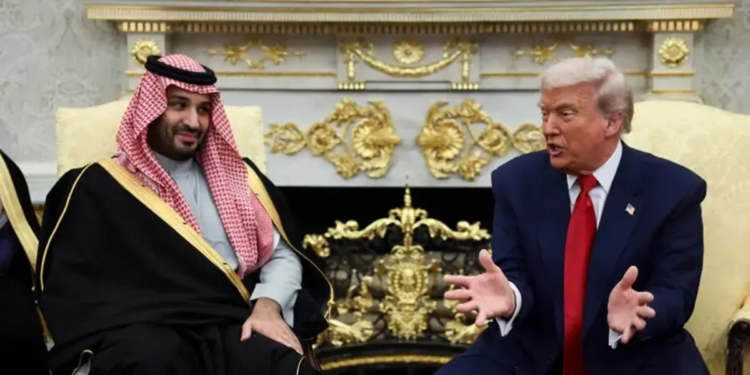Mohammed bin Salman’s visit to Washington will have offered a summary of the new American-Saudi diplomacy: spectacular in form, strategic in substance, and resolutely oriented towards a regional recomposition where money, defense and balance of power take the place of the central axis. Welcomed with unusual pomp, the Saudi crown prince found a triumphant Donald Trump at the White House, keen to consolidate a partnership that he now presents as essential to his vision of a “new Middle East”.
A cautious step towards possible normalization with Israel
At the heart of the exchanges, the question of normalization between Riyadh and Tel Aviv remains the most symbolic element. Trump and MBS say they have had “positive discussions,” suggesting that Saudi Arabia could eventually join the Abraham Accords.
But the crown prince remains firm: no progress without a credible path towards a Palestinian state. This reminder, intended as much for Arab public opinion as for international partners, underlines that Riyadh intends to maintain its status as regional leader while ensuring not to fracture its internal balances.
In a context where the United States seeks to redesign regional blocs around economic and security alliances, the Saudi position appears to be a major diplomatic lever – and a test for Washington.
A strategic status: Riyadh becomes “major non-NATO ally”
Donald Trump announced the granting of major non-NATO ally status to Saudi Arabia, joining a select club of 19 countries (including Tunisia).
For Riyadh, it is a qualitative leap: easier access to the most advanced weapons systems, accelerated procedures, strengthened cooperation.
This recognition is accompanied by a strategic defense agreement, designed to seal an 80-year-old partnership. Washington thus assures that it wants to “strengthen deterrence in the Middle East”, while Riyadh seeks to protect itself against regional uncertainties, from the Israeli-Qatari conflict to tensions with Iran.
This decision comes a few weeks after Saudi concluded a military pact with Pakistan, a sign that MBS intends to diversify security guarantees while anchoring its ties with Washington.
The F-35s, symbol of a rebalancing against Israel
The most sensitive announcement concerns the sale of F-35s to Riyadh. Trump assures that the devices will not be “degraded” to preserve the Israeli military advantage, breaking with the American doctrine of “qualitative military edge”.
The signal is strong: MBS no longer wants to be treated as a second-tier partner, and Washington seems ready to endorse this development.
This choice comes in a context where the United States wishes to stabilize its alliances in the Middle East, while preventing Riyadh from pursuing Asian options, particularly Chinese ones.
Iran: from confrontation to diplomatic opening
The Iranian file revealed an assumed double standard. Trump is again celebrating June’s U.S. strikes on Iran’s nuclear facilities, touting U.S. military superiority.
But he affirms at the same time that Iran “wants an agreement” and that it is “totally open” to a diplomatic process.
Notably, MBS publicly aligns: Saudi Arabia will support a potential US-Iran deal.
A gesture which shows the evolution of Riyadh since the reconciliation of 2023, and which confirms the desire to avoid a regional escalation while the military balance remains fragile.
Colossal investments: up to $1,000 billion
The economic dimension of the visit is just as decisive. Trump mentions a commitment to invest 600 billion dollars, MBS speaks of a potential total amount of 1,000 billion.
These flows would concern artificial intelligence, emerging technologies, critical materials, industry and finance.
This economic pact seals convergence:
- the United States is seeking new financing for its technological giants and their infrastructure,
- Saudi Arabia wants to consolidate its Vision 2030 strategy and become a central player in the technologies of the future.
MBS repeats that the United States is today the “hottest market in the world”, and that he intends to participate in its technological foundations.
Also read:








